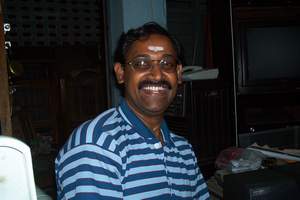Associate Professor,
Department of Physics,
Indian Institute of Technology - Madras,
Chennai - 600 036,
India.
Ph:091-044-22574883 (Off): 22576883(Res)

| Dr.V.Subramanian
Associate Professor, Department of Physics, Indian Institute of Technology - Madras, Chennai - 600 036, India. Ph:091-044-22574883 (Off): 22576883(Res) |
 |
| Publication | Projects | Research | Course I Handle | About My Lab | Students | |
| Some Photos --> | Germany | Russia |
|
Bio Data |
Born on 10th May 1967 at KALAKAD Village in TIRUNELVELI District, Tamil Nadu state, INDIA. Our family roots can be traced to Sivalaperi village near Tirunelveli and Kalakad (approx. 45 Kms from Tirunelveli).
The photograph of daughters Indu and Harini.

 Go Top |
Carrier transport studies on semiconductors at microwave frequencies.
Dielectric studies on liquids and liquid mixtures.
Preparation and characterisation of dielectric materials useful for microwave applications.
Dielectric dispersion studies on relaxor ferroelectrics.
Development of non-destructive microwave techniques for material characterization.
Microwave passive and illuminated imaging.
Microwave band gap structures.
Developed a
new microwave
technique, adjustable plunger cavity technique, for dielectric characterisation
of liquids at microwave frequencies.
Developed a new method of calculation of quality factor of the microwave cavity.
Developed a modified method, partial insertion approach, for dielectric characterisation of high loss samples using cavity perturbation technique.
Developed a modified approach for analysing the transient photo conductivity decay in polycrystalline semiconductors.
First to work on the carrier lifetime measurements in semiconductors using microwave technique in India – the only facility available in India.
Developed the facility for the study of electromagnetic shielding effectiveness of polymeric materials in the frequency range 0.5 to 30 GHz – the only facility available in India
Developed scanning near field microwave microscopy (SNMM) for high-resolution dielectric mapping of surfaces – the only facility available in India.
Developed microwave Hall effect experimental arrangement for the first time in India.First to work on the microwave band gap structures in India.
SPECIAL
LECTURES DELIVERED
The MINORITY CARRIER LIFETIME
in semiconductor materials play a key role in determining the material
quality in the device manufacturing process. The non-contact and
non-destructive microwave techniques are very much useful in this
context. The CAVITY PERTURBATON, one of the microwave techniques, provides a very sensitive and simple way of observing the MICROWAVE TRANSIENT PHOTO CONDUCTIVITY DECAY to
calculate the photo generated excess minority carrier lifetime. The
thesis work analyzes this technique to solve the experimental and
theoretical difficulties encountered in the measurement procedure. The
solutions are found to have wide range of applications in the
characterizations of condensed matter, viz. Phase Transition Studies in
Liquid Crystal, Triplet State Lifetime Studies in Organic Liquids apart
from the characterization of semiconductors.
A new methodology described in the thesis for the calculation of QUALITY FACTOR of a microwave cavity from the reflected power at resonance paves way for the real time measurements of carrier lifetime and SPECTRAL PHOTO CONDUCTIVITY
in semiconductors. The conventional perturbation theory using the
lumped circuit analysis requires that the sample be inserted fully into
the cavity while a modified theory is introduced for the partial
insertion of the sample. This improvement provides an advantage in
studying the variation of MOMENTUM RELAXATION TIME of carriers, BAND GAP and spectral photo conductivity in semiconductors.
Equipped fully with the measurement technique and an indigenously developed good quality DATA ACQUISITION SYSTEM,
the measurement of carrier lifetime in various semiconductor materials
under different external conditions were performed using both the
microwave and conventional Transient Photo Conductivity Decay with
contacts.
The thesis utilizes the sensitive nature of minority carrier
lifetime on the mobility of the carriers to study the temperature
dependence of minority carrier mobility (in Single Crystals), GRAIN BOUNDARY POTENTIAL and excess majority carrier mobility (in Poly Crystals using the SINGLE LOCALIZED TRAP STATE model).
Extending a similar study on POROUS SILICON, a
relatively new material, the temperature dependence of non-radiative
carrier lifetime was attributed to the mobility of the carriers and the
effect of pores.
Deviating from the lifetime-mobility nexus, an innovative idea
of correlating the free carrier lifetime with the BAND-BAND transitions
in semiconductors was put forward. This was applied on thin films of ZINC PHOSPHIDE by using the OPTICAL MODULATION TECHNIQUE in conjunction with the MICROWAVE REFLECTION TECHNIQUE.
The SPECTRAL DEPENDENCE OF TRANSIENT OPTICAL ABSORPTION and SPECTRAL DEPENDENCE OF CARRIER LIFETIME obtained from the measurements proved that the band-band transitions can be detected from the carrier lifetime.
In short, the thesis deeply involves various aspects on the measurement
and the subsequent analysis of the transient photo conductivity decay
in different kinds of semiconductors.

Go Top
| � 2007 Dr.V.Subramanian. All rights reserved. |